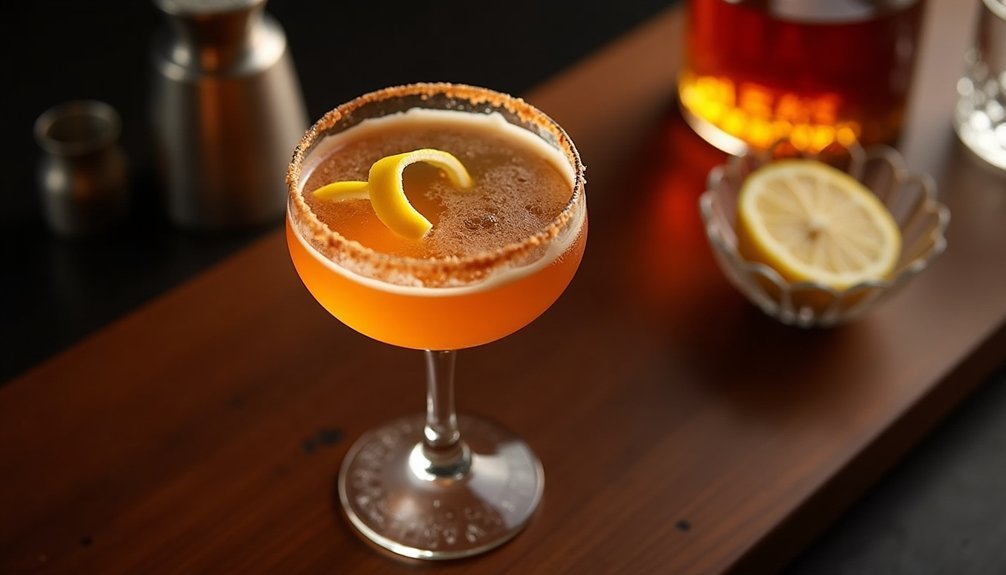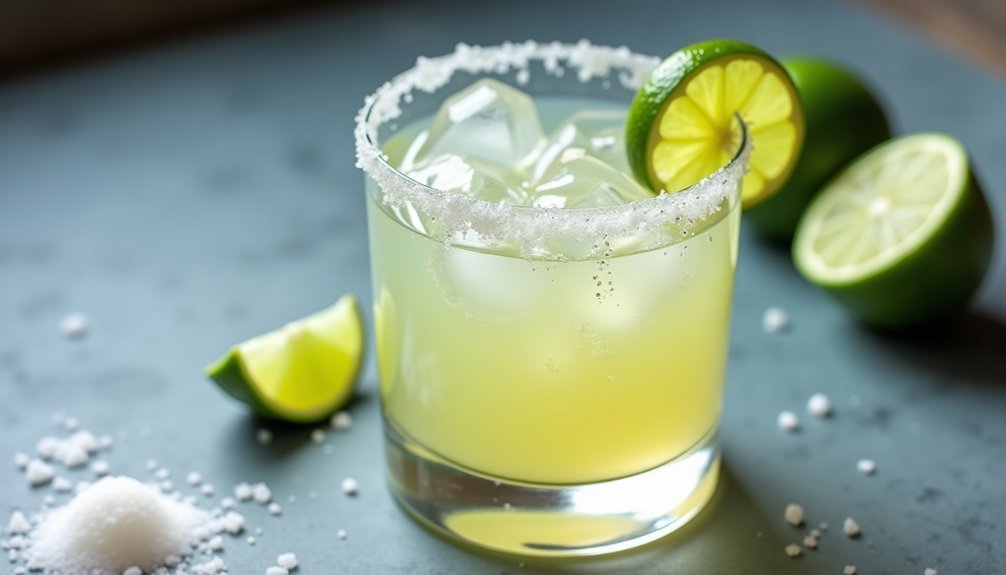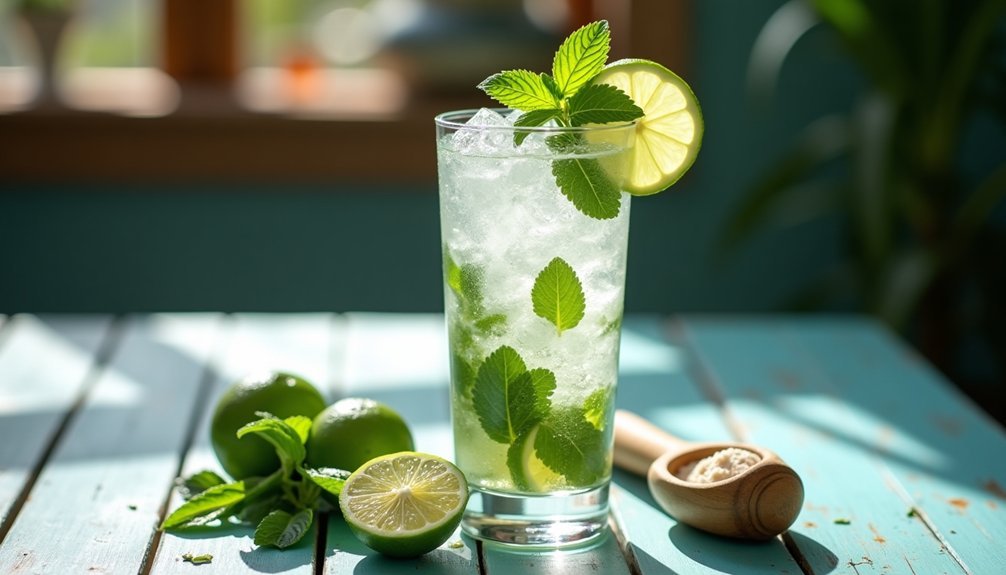I’ve always considered the Classic Sidecar one of the most underrated cocktails in the modern bar scene. It’s a perfect balance of tart and sweet, with that distinctive brandy warmth that just hits differently than other spirits. If you’re tired of the same old martinis and manhattans, this citrus-brandy gem might be exactly what your cocktail repertoire needs. The beauty lies in its simplicity—just three main ingredients—but the flavor complexity? That’s where things get interesting…
What Ingredients are in Classic Sidecar Cocktail?
The Sidecar cocktail is one of those timeless classics that perfectly balances sweet and sour flavors in an elegant package. Dating back to the early 20th century, this sophisticated drink features the rich warmth of brandy or cognac paired with bright citrus notes.
It’s the kind of cocktail that makes you feel a bit fancy when you’re sipping it, even if you’re just lounging at home in your pajamas. Ready to channel your inner bartender? Let’s gather these simple but essential ingredients.
Ingredients:
- 1.5–2 oz brandy or cognac (the backbone of the cocktail)
- 0.5–1 oz orange liqueur (Cointreau, Triple Sec, or Orange Curaçao)
- 0.75 oz freshly squeezed lemon juice
- Optional: 0.25 oz simple syrup (for those who prefer a slightly sweeter version)
- Lemon or orange twist for garnish
- Optional: sugar for rimming the glass
When it comes to making a truly memorable Sidecar, the quality of your ingredients makes all the difference. Can you get away with using bottled lemon juice? Sure, in a pinch.
But freshly squeezed lemon juice brings a brightness that the bottled stuff just can’t match. Similarly, while any brandy will work, a good cognac elevates this cocktail from good to unforgettable.
And don’t forget about presentation—serving your Sidecar in a proper cocktail glass with that sugared rim isn’t just for looks, it adds another dimension to the flavor experience as you sip.
How to Make this Classic Sidecar Cocktail

Making a Sidecar is one of those bartending skills that looks impressive but is actually quite simple. Start by deciding whether you want that fancy sugar rim—if you do, take a lemon wedge and run it around the edge of your cocktail glass, then dip the moistened rim into a small plate of sugar. This sweet touch balances the cocktail’s natural tartness, but it’s completely optional if you prefer your drinks on the drier side.
Now for the magic part. Grab your cocktail shaker and fill it with ice—not just a few cubes, but a generous amount that will quickly chill your mixture. Pour in 1.5–2 oz of your brandy or cognac (depending on how strong you like it), followed by 0.5–1 oz of orange liqueur, and 0.75 oz of freshly squeezed lemon juice. If you’re catering to someone with a sweet tooth, you might want to add that optional 0.25 oz of simple syrup.
Then shake it vigorously—and I mean really put your shoulder into it! You’re not just mixing ingredients; you’re also properly diluting and chilling the cocktail, which affects the final texture and taste.
Once your hands feel cold from holding the shaker (that’s how you know it’s ready), strain the golden liquid into your prepared glass. The Sidecar should have a beautiful amber hue that catches the light just so.
Finish with a twist of lemon or orange peel—giving it a little squeeze over the drink first to express those fragrant oils onto the surface. And there you have it—a classic Sidecar cocktail that would make any prohibition-era bartender proud.
Isn’t it amazing how three simple ingredients can create something so sophisticated? Investing in a luxury cocktail bar set will elevate your home bartending experience and make creating classics like the Sidecar even more enjoyable.
Substitutions and Variations
While traditional recipes have their place in cocktail history, part of the fun of mixology comes from playing with different ingredients to suit your taste or pantry situation.
Don’t have cognac? Try a quality bourbon or aged rum instead. The drink takes on a whole new personality, but keeps that lovely balance of sweet and sour.
For a fruitier twist, I recommend adding a splash of pomegranate juice or substituting blood orange liqueur for the Cointreau.
Love it sweeter? Increase the orange liqueur and add a touch more simple syrup.
Prefer something drier? Skip the sugar rim and reduce the sweeteners.
What to Serve with Classic Sidecar Cocktail
Now that we’ve explored some creative variations, let’s consider what foods pair beautifully with this citrusy, sophisticated sipper.
The Sidecar’s bright lemon notes and warming cognac create delightful contrasts with certain dishes.
I find charcuterie boards with smoky meats and creamy cheeses balance the cocktail’s acidity perfectly.
Oysters or shrimp cocktail? Divine companions. The citrus cuts through seafood’s brininess in the most revitalizing way.
For heartier pairings, try duck confit or mushroom pâté—the richness stands up to the Sidecar’s bold personality.
And don’t overlook dessert options like lemon tarts or crème brûlée, which mirror and complement the drink’s citrus-sweet profile.
Final Thoughts
The classic Sidecar cocktail deserves a permanent spot in your home bartending repertoire, as it perfectly balances sophisticated flavors with straightforward preparation.
I’m consistently amazed by how three simple ingredients—cognac, orange liqueur, and lemon juice—can create such a harmonious blend of sweet, sour, and warmth.
What makes this drink special? Perhaps it’s the way it bridges casual and formal occasions, or how it welcomes customization while honoring tradition.
Maybe it’s simply that first sip, when the sugar rim meets the tart-sweet liquid.
Ready to impress your guests with minimal effort and maximum flavor? The Sidecar awaits.



